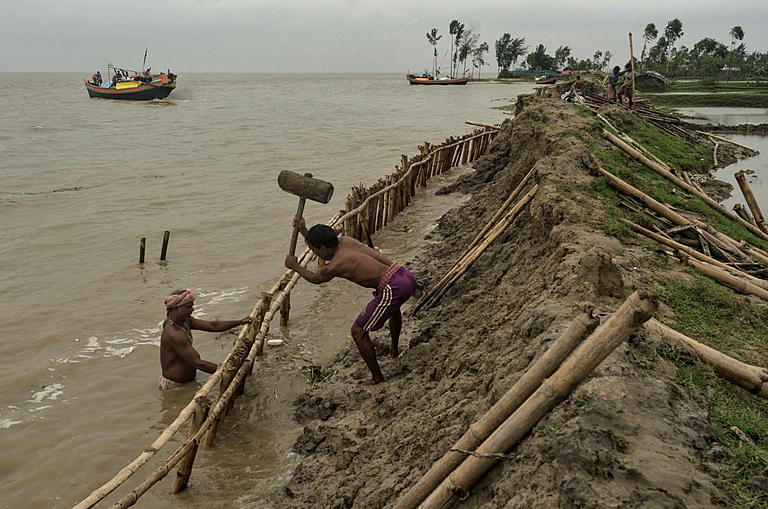The transboundary implications of climate-related coastal migration: state of knowledge, factors of influence and policy pathways

Introduction
With sea-level change (SLC), coastal human migration might become a major issue in the twenty-first century. Even if most of the mobility related to SLC will probably remain within national borders, this phenomenon raises major global-scale ethical and geopolitical challenges.
Human mobility from or to coastal areas is not a risk itself and can be an effective adaptation option, if chosen, prepared and anticipated in a fair and coordinated way by various actors. This calls for strengthened multi-level cooperation.
This study takes a deep dive into the cascading effects of coastal migration across borders and the types of policies that can support migration as a positive long-term adaptive strategy (reducing the vulnerability of migrants’ exposure to climate change and reducing the risks of maladaptation). It explores the following questions:
- Why and how is coastal migration happening?
- How can transboundary adaptation strategies minimize negative impacts or maladaptation (and henceforth support positive outcomes)?
- What are the key actions to be undertaken to anticipate, prepare and facilitate such flows?
- What are the existing policy frameworks or those to be strengthened?
- And how to sequence them over time, from now to the longer term?
*A synthesis can be found below, drawing on the paper and the associated blog on the IDDRI website. Download the full publication from the right-hand column for more details.
Methodology
The study is first based upon a desk review and assessment of existing scientific and grey literature. About 200 studies have been considered dealing with the topics of coastal impacts, coastal migration, climate migration and sea-level rise.
In addition to the literature review, semi-structured interviews were conducted with 14 international experts on coastal risks and migration.
Key messages
- Little knowledge exists on the cascading implications of coastal migration across borders and, as a result, there is limited work on enhancing adaptive migration and relocation when relevant. Putting in place a governance framework and relevant policy tools to anticipate and prepare for migration from or to coastal areas can positively contribute to climate adaptation for migrants, the country of origin and destination.
- This calls for an integrated approach of policies at multiple scales over time, in order to create synergies between national policies and international frameworks. This is what this study refers to as “policy pathways” (Fig. 4 in the report).
- 5 main policy pillars have been identified to tackle the main influential factors of risks related to changing migration patterns caused by sea-level change: (i) implementation of ambitious mitigation and international support for adaptation; (ii) effective coastal risk reduction policies; (iii) robustness of migration policies allowing for planning the movement of people across borders; (iv) enhancement of hosting capacities; (v) empowerment of communities and individuals through preparedness and right to decide.
- Cooperation between different scales of action might prove beneficial as it could foster rapid progress and coherence, while a lack of coordination and delay in implementing some policy pillars might hinder progress and have negative feedback effects (Fig. 5 in the report).
The characterization of transboundary climate risks: the case of coastal migration
The study addresses a major gap. Few studies address the cascading effects (positive and negative) associated with migration and how to prepare for them. By characterizing those main influential drivers of cascading effects, policy pillars can be identified (Figure 1). As further described in IDDRI’s study, designing appropriate policies and governance arrangements across scales (community, national, to multilateral) means migration can be facilitated in transboundary adaptation strategies and avoid negative impacts or maladaptation.
Policy pathways to anticipate and prepare for transboundary climate risks
The study proposes policy pathways designed to enable a systemic and flexible approach to adjust to uncertainties related to transboundary climate risks.
In the case of coastal migration, five policy pillars for adaptation-compatible migration are identified:
- Implementation of ambitious mitigation and international support for adaptation, which includes attention to loss and damage (see Warsaw International Mechanism for Loss and Damage – WIMLAD);
- Effective national to local coastal risk reduction policies;
- Development of robust migration policies that would allow to plan for the movement of people across borders;
- Enhancement of hosting conditions, and
- Participatory measures to ensure the empowerment of communities and individuals, through preparedness and right to decide.
Figure 2 illustrates multi-scale and sequenced policy pathways using a high ambition scenario for migration and a time horizon towards 2050 in order to be compatible with both scientific and policy concerns and challenges.
This scenario shows examples of key interdependencies (positive and negative influences) between the policy pillars. For example, empowering communities that are vulnerable to climate migration will reinforce adaptive capacity and informed choice; in contrast, delaying coastal retreat in highly exposed areas could lead to severe delays in adaptive capacity and hamper the development of mobility agreements in regional/international governance.
The need for a deeper dive into transboundary climate risks
The coastal migration study illustrates a need for a multi-scale approach across international processes, governments, private sector, and civil society, including the empowerment of vulnerable groups in society (e.g. migrant community’s right to choose). The latter echoes important discussions on climate migration under the UNFCCC WIMLAD working group and the operationalization of the Santiago Loss and Damage Network.
A deeper dive into major global transboundary climate risks could provide a better understanding of the characterization of these risks, and help design multi-scale and sequenced policy pathways—which could provide policymakers and practitioners with a means for coordinated responses in building global resilience
Conclusions
The study highlights, first, that coastal migration should not be considered as a risk in itself. If planned accordingly, migration can reveal positive outcomes for migrants, hosting communities, and the global society. However, there is currently little knowledge on the positive and negative cascading consequences of changing migration patterns across borders due to SLC. As a result, there is not enough strategic vision on policy and governance arrangements needed to facilitate adaptive solutions (including migration, when relevant) and avoid eventual maladaptation in both the countries of origin and destination.
The study highlights that managing and anticipating the cascading effects of coastal migration across borders calls for coordinated action both at the country level (country of origin and destinations) and across countries (Fig. 4), and that synergies are to be sought between national policies and international frameworks.
This way, it argues that there are strong interdependencies between policies at the national and global levels, as some decisions and policy processes at a given scale influence decision-making and action at other scales by creating positive or negative feedback loops (Fig. 5).
It therefore concludes that addressing the potential cascading effects of human coastal migration across borders calls for an integrated approach of climate change impacts and migration policies over time. This is what this study formulates as “multi-scale policy pathways’’. These pathways are a forward-looking approach, paving the way for more dialogue and cooperation between different stakeholders in the short-to-longer term, on coastal migration.

Comments
There is no contentYou must be logged in to reply.